Estate Jewelry: Hippocampi, 18th Century Febreze, and a Circus You Can Wear
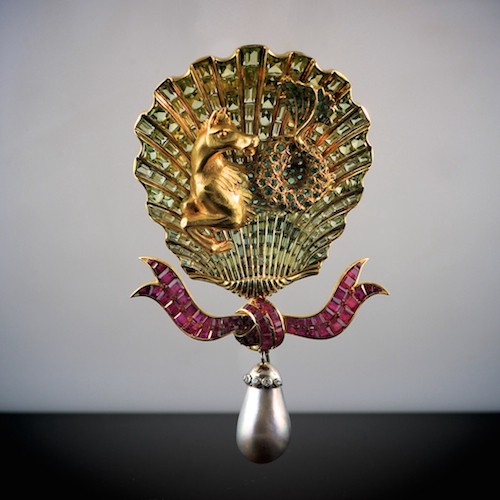
A couple of weeks ago, I stumbled across an unusual antique scrimshaw pie crimper that was carved in the shape of one of my favorite mythological creatures: a hippocamp. Half horse and half fish or sea-serpent, the hippocamp (or hippocampus) appears in Greek, Phoenician and Etruscan mythology, and Poseidon, the Greek god of the sea, is often shown driving a chariot pulled by hippocampi. The gestural horsey/ fishy characteristics essential to the hippocamp are nearly impossible for an artist to resist, and they’ve been depicted in various forms — coins, mosaics, painting, sculpture — for centuries. You can scroll back through my Twitter feed for some examples, but definitely don’t miss this incredible late 16th century Spanish hippocamp pendant in the collection of the British Museum, and also don’t forget about the famous 18th century Trevi fountain in Rome, which depicts Neptune, the Roman counterpart to Poseidon, overlooking two rearing hippocampi (and a couple of tritons).
If you happen to have what is no doubt a lot of cash, you can always pony up for this amazing hippocamp brooch that’s currently available from Lucas Rarities in London. Circa 1939, the piece was designed by Juliette Moutard for the French jewelry house Boivin, and features a golden hippocamp with an emerald-studded tail. It’s nestled in a shell set with even more emeralds, and a ruby bow suspends a natural saltwater pearl pendant below. Gah.
If, like me, you take public transportation to work, you may want to invest in a nice little vinaigrette. No, I don’t mean the salad dressing. The vinaigrette I’m talking about is a tiny little box or container that men and women carried with them to help mask unpleasant scents in their immediate surroundings, generally during the late 18th- to mid-19th centuries. Consider it an early version of Febreze. Vinaigrettes usually had a hinged lid, and held smelling salts or a tiny sponge beneath a pierced interior grill. The sponge could be soaked in a perfume or other aromatic substance like vinegar (hence the name).
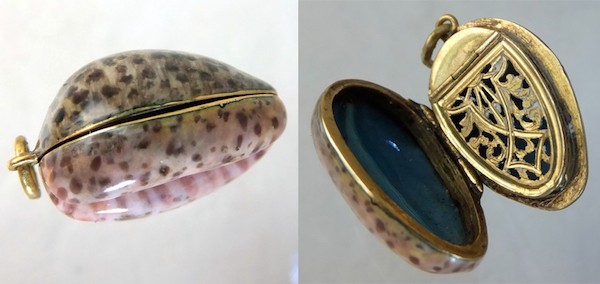
Peter Szuhay is selling this beautiful little gold vinaigrette that was designed in the form of a cowrie shell. Circa 1780 and probably French, it is enameled both inside and outside, and finished with a very pretty pierced and engraved interior grate.
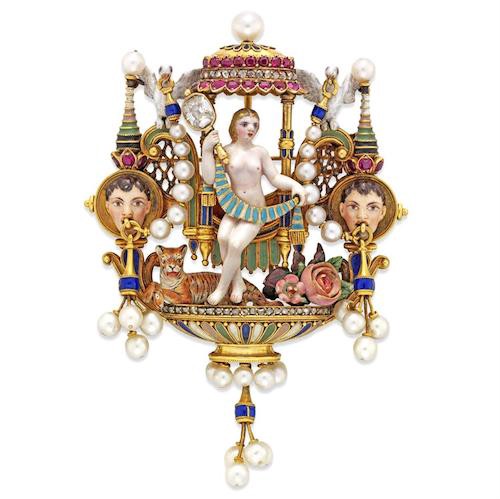
Now, I know I’ve gushed about Carlo Giuliano many times in the past and you’re probably sick of hearing about him, but let me just mention him again, because this brooch from Bentley & Skinner is insane. Circa 1890, it’s classic Renaissance Revival territory for Giuliano, but let’s just take it apart a little. There’s a figure of Venus holding a diamond mirror at center, with roses and a smiling, reclining tiger at her feet. She’s seated in a little cupola-like thing, and doves at either side of the ruby-set roof suspend pearl drapes from their beaks. The pearls loop down to two male masks that are also supporting pearl drops. The piece is gold, with various shades of enamel, rubies, diamonds, and a ton of pearls. It’s like a circus you can wear (for $378,000).
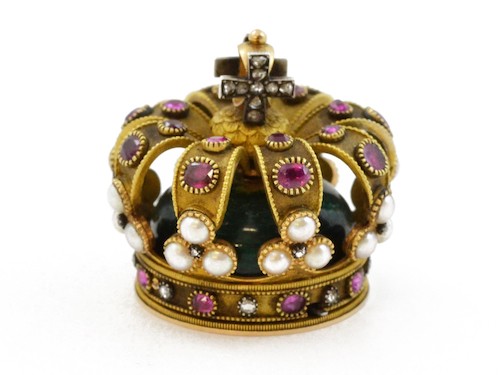
This sweet little English crown is hiding a surprise. Circa 1840, it’s a seal that would have been worn as a decorative watch fob, and it features rubies, pearls and diamonds set alongside textured gold detailing. The interior section of the crown is covered in green guilloché enamel, and it conceals an inner mechanism. This piece is actually musical; it features a disc and comb movement that plays eleven notes.
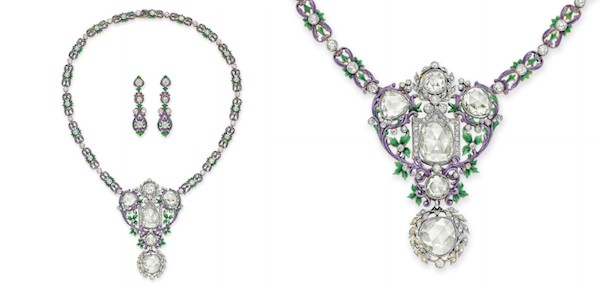
It’s auction season again, and you’ll have to bear with me, because apparently I’m in a bracelet mood. But before I get into the upcoming stuff, I have to mention the Christie’s Magnificent Jewels auction, which happened last week in New York. It featured a Belle Époque set of necklace and earrings by the brilliant Tiffany & Co. designer Paulding Farnham (yeah, I’ve mentioned him before, too). Circa 1900, the set surrounds diamonds with delicate enameled floral motifs in shades of purple and green, creating an overall light, airy effect that belies the fact that those are some SERIOUS diamonds. The set was estimated at $150,000-$250,000, and sold for $389,000.
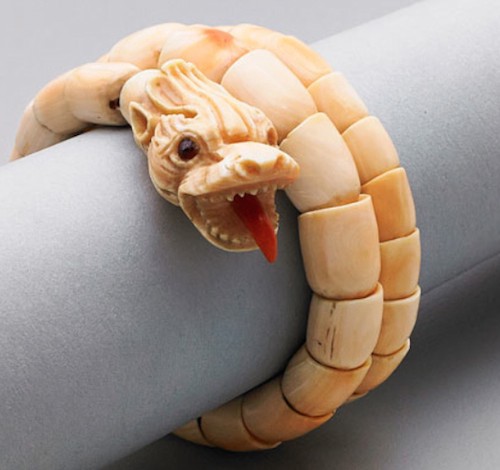
So, first up is the Rago Arts Jewelry and Silver auction on Sunday, April 27. This is an unreserved auction, so good deals may be had, and a lot of the estimates are very reasonable. I particularly adore this Victorian sea serpent bracelet. Circa 1850 and from Southern Italy, it’s made of shell, with a coral tongue and a ruby eye. A similar bracelet was recently sold by Bell and Bird, so if you missed that one, here’s your chance.
On Monday, April 28, Doyle New York will hold their Important Jewelry auction. One of the highlights of the sale is a rare and important pair of natural pearls that were previously owned by a U.S. railroad magnate and may have also been in the collection of Empress Eugenie of France. I’m totally in love with a ton of their bracelets, though. Look at this pink sapphire and diamond cuff in 18k rose and blackened gold! And this lovely Gothic Revival bracelet, with tiny, gleaming gem-set panels of gold and enamel! Aggggh.
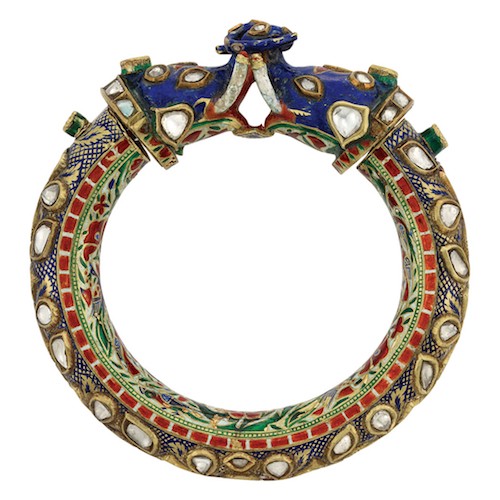
I’m always a sucker for Indian jewelry, though, and this elephant bangle is a delight. Royal blue enamel, gold leaf and table-cut diamonds decorate the body of the bangle, while the interior is enameled in a multicolored floral motif. The bangle terminates in two diamond-set elephant heads, with trunks joined by a coiled snake.
The Sotheby’s New York Magnificent Jewels auction is next Tuesday, April 29, at 10am. As usual, there are some giant stones — like this 15.23-ct Fancy Intense Orangey Pink diamond ring (estimate $6–7 million), and this 28.18-ct square emerald-cut sapphire and diamond ring by Oscar Heyman & Brothers (estimate $4–5 million).
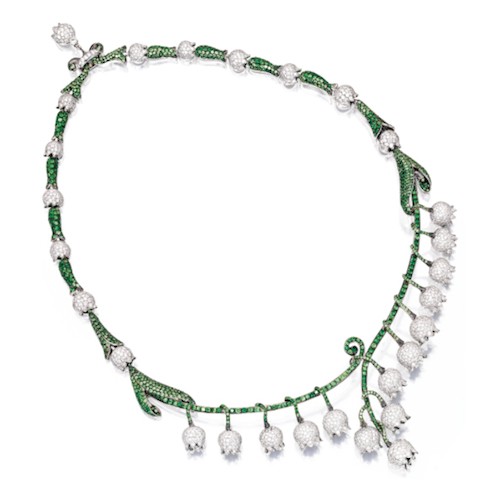
This contemporary lily of the valley necklace is another stunner. By Italian designer Michele della Valle, the piece features bright tsavorite garnet stems, with delicate little buds comprised of 17.82 carats of round diamonds. Della Valle’s intention is to create “cheerful” jewelry; you can read more about him in this great profile written by jewelry historian Vivienne Becker in anticipation of this auction.
The Bonhams Fine Jewellery auction in London on April 30 has got a pretty great tiara. Circa 1900, it features a central crescent moon and sun motif flanked by shooting stars, all in old brilliant-cut diamonds set in gold.
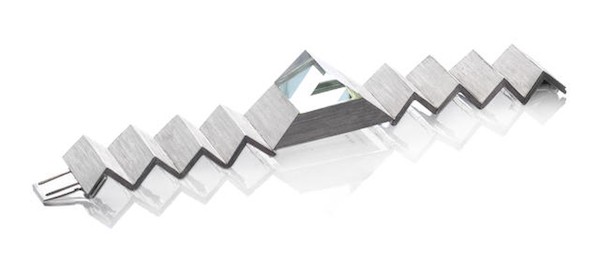
On the other end of the style spectrum is this fantastic and slightly dangerous-looking white gold and aquamarine watch, circa 1970, by Andrew Grima. Grima was born in Rome but raised in England, and his designs were the toast of London society in the 1960s and ’70s. The watch is part of his famous “About Time” collection, which was commissioned by Omega in 1969. Grima was playing with the concept of viewing time through gemstones — substituting out the usual glass watch crystal with a semiprecious stone.
Grima died in 2007, but his wife and daughter have kept the business going.
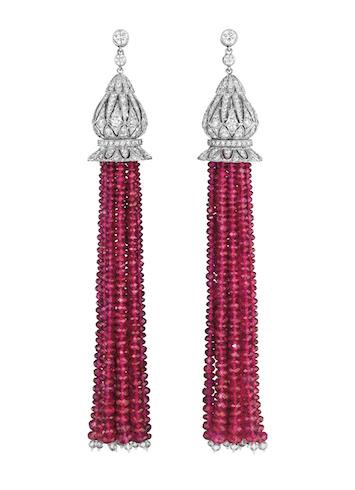
The April 30 Jewels auction at Phillips New York offers a much more organic-looking Grima design in this Brazilian topaz and diamond pendant/ brooch, also from 1970.
This auction also has some big rings — including this 11.20-ct Colombian emerald with diamond shoulders — but I also like these earrings. Featuring Burmese ruby tassels suspended from openwork platinum and diamond caps, they’re nearly four inches long and probably weigh a ton, but who cares.
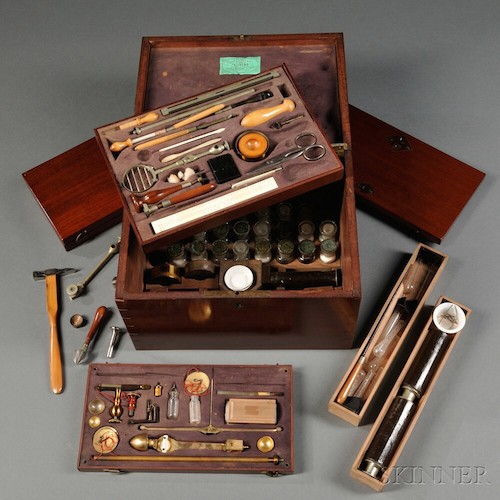
OK, totally not jewelry, but still cool and kind of related to jewelry? This is an assayer’s kit that is being offered in the Clocks, Watches & Scientific Instruments auction at Skinner’s Marlborough, MA location on May 3. Circa 1865, the kit was made by August Lingke & Co. of Freiberg, Germany. The case itself is dovetailed mahogany with a hinged lid, and it contains a velvet-lined, fitted upper tray with a bone scale and various other instruments. Inside are two other layers, also holding tools and instruments (including another scale in its own fitted box), and a selection of glass jars that hold the chemicals used to test the composition of various metals and minerals.

Freeman’s in Philadelphia is holding a Jewelry & Watches auction on May 5 at noon. They have quite a few nice things, but I’m particularly taken with this little sterling silver purse watch by Cartier. The case, which is engraved to look like an envelope, slides open from the center to reveal the watch. The “stamp” is dated April 17, 1941 and the name “Miss Nellye Grey, Oak Ridge Virginia” is engraved in a free-hand style on the front. I assume Nellye was the original owner? A pink gold version from 1943 sold at Sotheby’s last June, but the engraving is much more traditional.
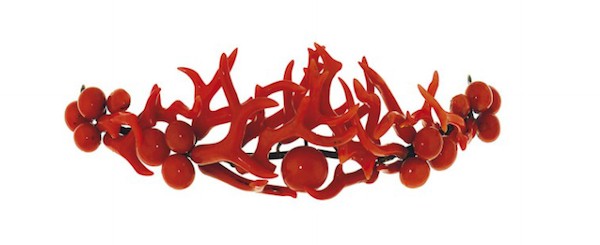
And finally, Christie’s London will hold a Jewels & Watches auction on May 21. They’re offering this beautiful tiara, circa 1830, that is composed of carved and button-shaped red coral set on a wire frame. Coral was hugely popular in the 19th century, and was believed by some to ward off the evil eye. Nowadays it’s so endangered that it comes under fierce restrictions by the U.S. Fish and Wildlife Service. Usually items that are at least 100 years old can be imported into the country, but proof is required, and possibly a permit as well. If you’re ever abroad and want to buy something that might fall under the endangered species umbrella — coral, ivory, tortoiseshell, etc — definitely make sure you can bring it into the country legally, or just don’t buy it at all.
Previously: Millennial Octopi and The Perfect Handle for Your Parasol
Monica McLaughlin would reeeeeally like to cover this exhibit at the Kremlin, if anybody wants to, you know, pay for her to get there.